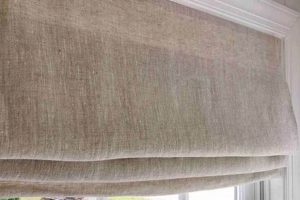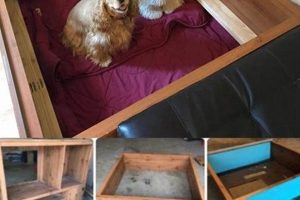The construction and creative reuse of discarded wooden pallets have gained significant traction as a resourceful method for crafting furniture, decorative elements, and functional structures. For example, individuals might dismantle a pallet to construct a coffee table, headboard, or vertical garden, minimizing material costs while engaging in environmentally conscious practices. The appeal lies in the accessibility and adaptability of the source material.
Utilizing reclaimed pallets offers various advantages, including cost savings, promotion of sustainable resource management through waste reduction, and the opportunity to personalize living spaces with unique, handcrafted items. Historically, resourcefulness in construction has been driven by necessity, but this contemporary trend reflects a broader awareness of environmental impact and the desire for individualized design solutions. This approach allows for the creation of customized solutions tailored to specific needs and aesthetics.
Subsequent sections will detail specific project ideas, provide guidance on pallet selection and preparation, address safety considerations associated with working with reclaimed wood, and explore the range of finishes and treatments applicable to pallet-based constructions. Understanding these aspects is crucial for successful and safe execution of such endeavors. This guide aims to provide a solid foundation for engaging with this popular form of upcycling.
Essential Considerations for Pallet-Based Construction
Successfully repurposing wooden pallets requires careful planning and execution. Adhering to the following guidelines will maximize project safety, durability, and aesthetic appeal.
Tip 1: Source Pallets Responsibly: Prioritize pallets stamped with “HT,” indicating heat treatment. Avoid those marked “MB,” signifying methyl bromide fumigation, a toxic process. Verify the pallet’s history and intended use where possible to mitigate potential contamination.
Tip 2: Thoroughly Inspect Pallets: Before disassembly or modification, carefully examine the wood for signs of damage, including cracks, rot, insect infestation, and protruding nails or staples. Discard compromised pallets to prevent structural failure or injury.
Tip 3: Prioritize Safety: Wear appropriate personal protective equipment, including safety glasses, gloves, and a dust mask, when working with pallets. Employ proper lifting techniques to prevent back injuries. Ensure adequate ventilation when sanding or applying finishes.
Tip 4: Disassemble with Precision: Use specialized tools, such as a pallet buster or reciprocating saw, to carefully dismantle pallets without damaging the wood. Avoid excessive force that can lead to splintering or breakage. Extract nails and staples completely to prevent injury during subsequent stages.
Tip 5: Sanding and Preparation: Pallet wood is often rough and uneven. Thorough sanding is essential to create a smooth, safe surface for furniture or decorative applications. Progress through varying grit levels to achieve the desired finish. Proper preparation ensures optimal adhesion of paints, stains, and sealants.
Tip 6: Sealing and Finishing: Applying a protective sealant or finish enhances durability and resistance to moisture, UV radiation, and wear. Select appropriate products based on the intended use of the finished project. Consider using non-toxic, low-VOC options to minimize environmental impact and potential health risks.
Tip 7: Design for Stability: When constructing furniture, prioritize structural integrity and stability. Reinforce joints with screws, brackets, or adhesives as needed. Ensure proper weight distribution to prevent tipping or collapse. Consider the intended load capacity when designing pallet-based structures.
These precautions are vital for successful projects and promote safety. Attention to pallet sourcing, preparation, and construction techniques increases the lifespan and utility of these upcycled materials.
The following sections will offer specific project guides, demonstrating how these principles can be applied practically.
1. Pallet Sourcing
The success of any DIY pallet project is inextricably linked to the initial sourcing of the pallets themselves. Pallet origin and treatment directly affect the project’s safety, durability, and potential aesthetic appeal. For instance, the use of chemically treated pallets in a garden setting can contaminate soil, impacting plant health and posing risks to human health. Conversely, selecting pallets that have undergone heat treatment (HT) mitigates the risk of chemical exposure, making them a safer choice for indoor and outdoor applications.
Furthermore, the type and condition of the wood significantly influence the project’s outcome. Hardwood pallets, such as those constructed from oak, offer greater structural integrity and resistance to wear, making them suitable for furniture construction. Softwood pallets, while easier to work with, may require additional reinforcement or protective coatings. Real-world examples include crafting sturdy outdoor benches from oak pallets or creating lightweight, decorative wall panels from pine pallets. The practical significance of understanding these differences allows for informed decision-making, resulting in a finished project that aligns with both the intended purpose and aesthetic preferences. Consider, for example, using damaged or weathered pallets to intentionally create a rustic aesthetic, adding character and individuality to the finished piece.
Ultimately, responsible pallet sourcing is not merely a preliminary step but a foundational element that determines the viability and longevity of DIY pallet projects. Challenges in sourcing appropriate pallets, such as limited availability or inconsistent quality, may necessitate adjustments to the project design or material selection. Recognizing and addressing these challenges proactively enhances the likelihood of a successful outcome, contributing to the broader trend of sustainable upcycling and resourceful construction practices.
2. Safety Protocols
The successful completion of DIY pallet projects is predicated on the strict adherence to safety protocols. Failure to observe established safety measures can result in physical injury, structural compromise of the project, or exposure to hazardous materials. Pallet wood, often of unknown origin, may harbor embedded nails, splinters, or contaminants. Rough handling or improper dismantling techniques introduce the risk of cuts, punctures, and musculoskeletal strain. A lack of awareness regarding wood treatment processes, such as chemical fumigation, can lead to respiratory irritation or dermatological reactions.
Safety protocols encompass several crucial aspects: personal protective equipment (PPE), proper tool usage, and awareness of material hazards. Eye protection, such as saf
ety glasses, mitigates the risk of projectile debris during sawing, sanding, or nail removal. Gloves protect hands from splinters, rough surfaces, and potential chemical exposure. Respirators or dust masks minimize the inhalation of airborne particles generated during sanding or cutting operations. The selection of appropriate tools, such as pallet busters or reciprocating saws designed for dismantling pallets, reduces the likelihood of damage to the wood and enhances user safety. Thorough inspection of pallets for protruding nails, staples, or signs of decay is essential before commencing any project.
The practical significance of understanding and implementing safety protocols is evident in numerous real-world examples. Individuals who neglect eye protection during dismantling operations are at increased risk of eye injuries from flying debris. Failure to wear gloves can result in painful splinters or contact dermatitis from handling treated wood. Overlooking structural weaknesses in the pallet wood can lead to furniture collapse, causing injury to users. Consequently, the integration of comprehensive safety protocols is not merely a precautionary measure but an integral component of successful and responsible engagement in DIY pallet projects.
3. Design Planning
The integration of structured design planning fundamentally influences the outcome of DIY pallet projects. Effective planning serves as the blueprint, dictating the project’s feasibility, structural integrity, and overall aesthetic appeal. Lack of foresight in design often results in structurally unsound constructions, inefficient material utilization, and ultimately, project failure. For instance, attempting to construct a pallet-based bed frame without calculating weight distribution or considering appropriate support structures can lead to collapse, rendering the project unsafe and unusable. Proper planning mitigates these risks by ensuring alignment between the project’s objectives and the inherent limitations of the pallet material.
A practical example lies in the construction of a vertical garden from pallets. Design planning involves not only determining the overall dimensions and configuration of the garden but also selecting suitable pallet types, preparing the wood to withstand moisture, and integrating a drainage system to prevent root rot. Without this pre-emptive planning, the project is likely to suffer from premature decay, instability, and an inability to sustain plant life effectively. Further application lies in furniture construction. Careful sketching and measurement taking allows the individual to visualize the end product; and this aids in the minimization of material waste.
In essence, design planning is the cornerstone of successful DIY pallet projects, transforming raw, recycled materials into functional and aesthetically pleasing creations. The challenges associated with design deficiencies underscore the need for careful consideration of structural requirements, material properties, and intended usage. Prioritizing planning not only enhances project outcomes but also contributes to the sustainability and longevity of upcycled pallet constructions. Understanding the intrinsic connection between design and execution is key to realizing the full potential of these resource-conscious endeavors.
4. Wood Preparation
Wood preparation stands as a crucial precursor to the successful completion of DIY pallet projects. The quality and longevity of the finished product are directly contingent upon the thoroughness and efficacy of this preparatory stage. Untreated or improperly prepared pallet wood presents a range of challenges, from structural instability to aesthetic deficiencies, undermining the overall viability of the project.
- Cleaning and Disinfection
Pallets, often exposed to diverse environmental conditions, can accumulate dirt, grime, and potentially hazardous contaminants. Thorough cleaning with appropriate detergents and, in some cases, disinfectants is necessary to remove these impurities. For instance, pressure washing can effectively eliminate surface debris, while solutions containing bleach can address mold or mildew growth. Neglecting this step can lead to aesthetic issues such as discoloration or, more significantly, health hazards associated with mold spores or bacterial contamination within indoor settings.
- Sanding and Smoothing
The rough-hewn nature of pallet wood necessitates sanding to create a smooth and even surface. Sanding removes splinters, sharp edges, and surface imperfections, enhancing both the aesthetic appeal and safety of the finished product. The use of orbital sanders with varying grit levels is common, progressing from coarser grits to finer grits to achieve the desired level of smoothness. Proper sanding also prepares the wood surface to receive paint, stain, or sealant, improving adhesion and finish quality. For example, an unsanded pallet used in furniture construction would result in a rough and uncomfortable surface, prone to snagging clothing and accumulating dirt.
- Repairing Damage
Pallet wood is often subject to damage such as cracks, splits, or missing sections. Addressing these structural weaknesses is essential to ensure the integrity and longevity of the project. Wood fillers, epoxy resins, or wood replacements can be used to repair these imperfections, restoring the wood’s structural integrity and providing a uniform surface for finishing. Ignoring damage can lead to structural failure, particularly in weight-bearing applications such as furniture or shelving. Replacing damaged sections is preferable where possible, ensuring strength and safety.
- Addressing Fasteners
Pallet construction typically involves the use of nails, staples, or screws. These fasteners often protrude or are unevenly driven, posing a safety hazard. Thorough removal or countersinking of these fasteners is crucial. Nail punches or pliers can be used to remove protruding nails, while countersinking ensures that fastener heads are flush with the wood surface, preventing injuries and creating a smooth surface for finishing. Incomplete fastener removal can lead to cuts, scratches, or damage to tools during subsequent processing.
In conclusion, wood preparation forms the foundation upon which successful DIY pallet projects are built. The facets of cleaning, sanding, repairing, and addressing fasteners are not isolated tasks but rather interconnected steps that contribute to the overall quality, safety, and durability of the final product. Neglecting these preparatory measures compromises the project’s integrity, whereas diligent execution ensures a lasting and aesthetically pleasing result, aligning with the core principles of resourcefulness and sustainability inherent in DIY pallet construction.
5. Protective Finishing
Protective finishing plays a critical role in the longevity and safety of DIY pallet projects. Unfinished pallet wood is susceptible to environmental damage, wear, and potential contamination. A properly applied protective finish mitigates these risks, extending the lifespan and enhancing the usability of pallet-based creations.
- Moisture Resi
stancePallet wood, often sourced from outdoor environments, is prone to moisture absorption. Untreated wood can warp, rot, or develop mold and mildew, compromising its structural integrity. Protective finishes, such as sealants and varnishes, create a barrier against moisture penetration, preventing water damage and preserving the wood’s dimensional stability. Real-world examples include outdoor pallet furniture, where a waterproof sealant is essential to withstand rain and humidity. Without adequate moisture resistance, such projects would quickly deteriorate, rendering them unusable.
- UV Protection
Exposure to ultraviolet (UV) radiation can cause fading, discoloration, and degradation of wood surfaces. Protective finishes containing UV inhibitors shield the wood from the harmful effects of sunlight, preserving its color and appearance. Outdoor pallet projects, such as garden planters or decorative screens, benefit significantly from UV protection. Failure to apply a UV-resistant finish can result in unsightly fading and premature aging of the wood, diminishing its aesthetic appeal and structural integrity.
- Wear Resistance
Pallet-based furniture and other functional items are subject to wear and tear from everyday use. Protective finishes, such as polyurethane or epoxy coatings, provide a durable surface that resists scratches, abrasions, and impacts. This is particularly important for high-traffic areas, such as tabletops or seating surfaces. Without wear-resistant finishing, pallet wood is vulnerable to damage from regular use, resulting in surface imperfections and reduced structural integrity over time.
- Contamination Prevention
Pallet wood can harbor dirt, grime, and potentially harmful contaminants. Protective finishes create a smooth, sealed surface that is easier to clean and disinfect, preventing the absorption of stains and bacteria. This is especially relevant for pallet projects used in food preparation or serving areas, such as cutting boards or serving trays. A food-safe finish is crucial to ensure that these projects do not pose a health risk to users. Proper sealing is vital for such items.
In summary, protective finishing is an indispensable aspect of DIY pallet projects. It not only enhances the aesthetic appeal of the finished product but also safeguards against environmental damage, wear, and contamination. The selection of appropriate finishes, based on the intended use and exposure conditions, is essential for ensuring the longevity, safety, and usability of pallet-based creations.
Frequently Asked Questions
The following section addresses common inquiries regarding the sourcing, preparation, and execution of projects utilizing reclaimed wooden pallets. Understanding these points is crucial for ensuring project safety, structural integrity, and long-term viability.
Question 1: What types of pallets are suitable for DIY projects?
Pallets marked with the “HT” stamp, indicating heat treatment, are generally considered safe for DIY applications. Avoid pallets marked “MB,” signifying methyl bromide fumigation, a toxic process. Pallets of unknown origin should be carefully assessed for potential contaminants or structural damage.
Question 2: Is it necessary to clean pallets before use?
Thorough cleaning is essential. Pallets can accumulate dirt, grime, and potential pathogens during transit and storage. Pressure washing, scrubbing with appropriate detergents, and, in some cases, disinfection are recommended to mitigate these risks.
Question 3: What safety precautions should be observed when working with pallets?
Appropriate personal protective equipment (PPE), including safety glasses, gloves, and a dust mask, is paramount. Pallets may contain splinters, protruding nails, or rough surfaces. Employ proper lifting techniques to prevent back injuries, and ensure adequate ventilation when sanding or applying finishes.
Question 4: How can the structural integrity of pallet wood be assessed?
Carefully inspect the wood for signs of cracks, rot, insect infestation, or warping. Compromised sections should be replaced or reinforced to ensure the project’s stability. Avoid using pallets with significant damage that could compromise the final structure.
Question 5: What types of finishes are appropriate for pallet projects?
The choice of finish depends on the intended use of the project. For outdoor applications, moisture-resistant sealants and UV-protective coatings are recommended. For food-related projects, food-safe finishes are essential. Consider low-VOC options to minimize environmental impact and potential health risks.
Question 6: How can the lifespan of pallet projects be maximized?
Regular maintenance, including cleaning and reapplication of protective finishes, is crucial. Address any signs of damage or wear promptly to prevent further deterioration. Proper storage during inclement weather can also extend the lifespan of outdoor pallet projects.
These answers reinforce the importance of safety and best practices when engaging in DIY pallet projects. Proper preparation and execution are critical for achieving successful and sustainable outcomes.
The following section will explore advanced techniques and project variations for experienced DIY enthusiasts.
Conclusion
This exploration of DIY pallet projects has emphasized critical aspects ranging from responsible material sourcing and stringent safety protocols to meticulous design planning, wood preparation, and protective finishing. Adherence to these principles dictates project success, structural integrity, and longevity.
Engaging in DIY pallet projects presents a resource-conscious approach to construction, offering potential for customized solutions and creative expression. However, responsible execution, guided by awareness of material properties, safety considerations, and environmental impact, is paramount to ensuring both the integrity of the project and the well-being of the individual.







